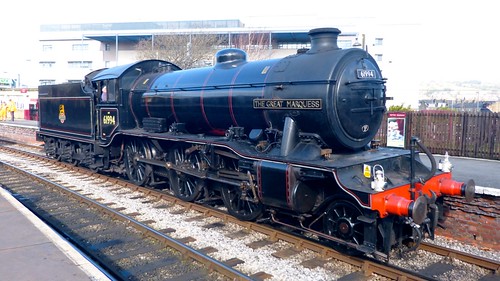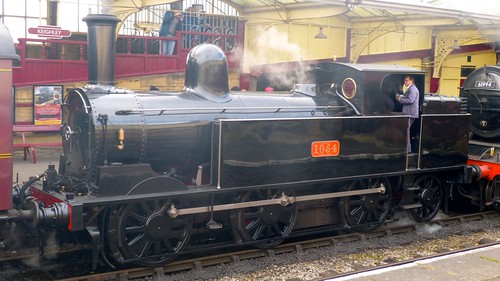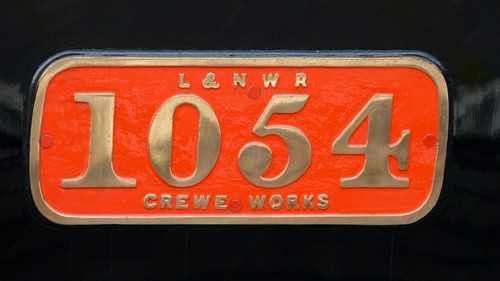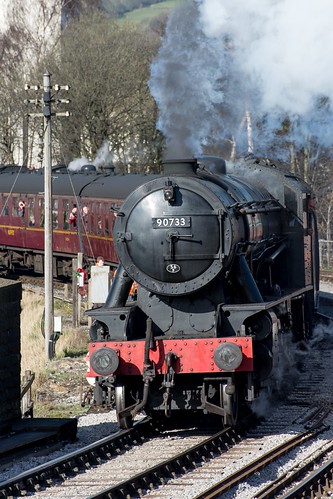Over the weekend of 7th. 8th. and 9th. of March 2014. The Keighley and Worth Valley Railway (K&WVR) put on a steam gala.
My son Andrew and I had the Friday there and as befitted the occasion we travelled by train.
From our home station we travelled to Leeds by ‘Northern Rail’ (NR) class 158872 and from Leeds to Keighley by ‘NR’
class 333.
While the ‘158’ wears ‘NR’s standard livery the ‘333’ wears the hybrid ‘NR’/West Yorkshire PTE ‘Metro’ livery.
95820
The star of the day for me was this former USATC 2-8-0 freight locomotive one of many supplied to Britain during the Second World War.
Sent initially to France and then on to Poland where it worked until repatriated to the 'K&WVR' in 1977. Withdrawn for overhaul in 1992, it returned to service early in 2014 and this gala was its service debut.
The loco carries a fictional livery that has caused some comment in preservation circles.
Personally, I like it as it is in keeping with the type of loco and set in the style of the times.
The two additional images show the information plates set high on the boiler.
No. 61994 The Great Marquess
Designed by Sir Nigel Gresley and built as a K4 class loco in 1938 by the LNER and numbered 3442 in service. The class was 6 loco’s strong.
The K4’s were designed specifically for the West Highland Line to Mallaig and Fort William.
Withdrawn in 1961 and sold into preservation it was stored on the Severn Valley Railway from 1972 until 1980 when it was overhauled.
Sold in the mid 2000 it was then overhauled at Crewe. It has since moved back to Scotland where it operates trains on the national rail network.
No. 43942
An 0-6-0 freight locomotive built by the Midland Railway in Derby. It was withdrawn in 1965 and sent to Woodhams Brothers scrapyard at Barry.
In 1968 it became the first loco ever to be rescued from a scrapyard. After a major overhaul it re entered service in 2011.
No. 1704 ‘Nunlow’
An 0-6-0T industrial tank loco. Built in 1938 by Hudswell Clark & Co. of Leeds it worked for Earle’s Cement at their factory at Hope in Derbyshire.
Sold in 1968, it is now owned by the Bahamas Loco Society and is based at the ‘K&WVR’.
No. 1054
An 0-6-2T Webb Coal tank originally of the ‘London & North Western Railway’ (L&NWR).
Designed in 1881 and built at Crewe in 1888. There were a total of 300 produced between 1881 and 1897.
At the grouping in 1923 it became the No. 7799 and then became No. 58926 on the formation of British Railways in 1948.
After a total of 70 years in service it was withdrawn in 1958 and was eventually sold into preservation at the price of £500. This was the first time a loco had been bought for preservation by public subscription.
Recently overhauled on the K&WVR the loco is owned by the National Trust and is looked after by the ‘Bahamas Locomotive Society’ (BLS).
I have ridden behind it and it is hard to believe that it is now 126 years old.
Another loco with the ‘BLS’ is No. 2258 ‘Tiny’. Currently non-operational, the loco is stored at the loco Museum at Ingrow.
Built by Andrew Barclay and Sons of Kilmarnock in 1947, this 0-4-0ST was for use at Manchester Corporation’s Gas Works.
It came into preservation with the ‘BLS’ in 1970 and moved to Keighley in the early 1990’s when the ‘BLS’ re-located.
No. 9073
A 2-8-0 Austerity which was a wartime design based on the LMS class 8F. Built by the Vulcan Foundry in 1945.
The loco worked in Holland for the Dutch State Railways before being sold in Sweden. Working for Swedish Railways (SJ) as its No. 1931 it was withdrawn in 1958.
Found in 1973 by a group from the ‘K&WVR’, the loco was repatriated to the UK in 1973 and finally entered service in 2007.
Seen ‘squealing’ its way round the curve just outside Keighley station, this image is the work of my son Andrew Basford to whom thanks are offered for its use.
















No comments:
Post a Comment